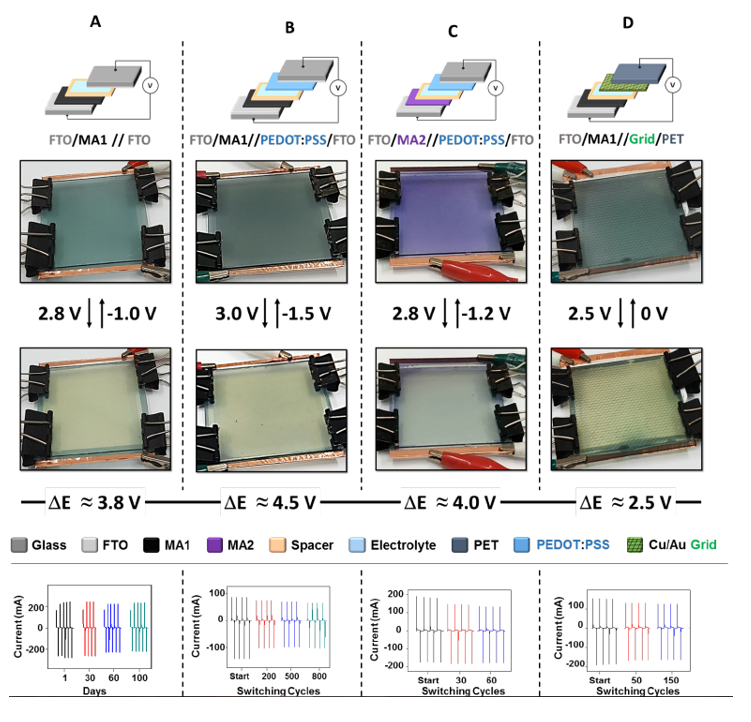High-performance electrochromic materials that exhibit a practical combination of low-voltage operation and efficient color-switching, as well as long-term stability have been developed by the group of Prof. van der Boom.
Electrochromic materials that are currently available in the market offer a broad range of colors and a fair electrochromic activity. For the incorporation of such materials into a wide range of real-world applications, there is a need for more intense coloration, shorter switching times and improved stability.
The trends towards energy efficiency, comfort and privacy are driving forward the commercial use of smart glass, the largest market segment of electrochromic materials. Smart glass can involve different kinds of technologies:
- Thermochromic materials are generally more affordable, although not user-controlled.
- Liquid crystal technology is superior in terms of switching speed and the opacity of the dark state. However, it is expensive and has low controllability as only two states (clear or opaque) can be achieved.
- Suspended particle technology combines high switching speed and user control but is extremely expensive.
- Electrochromic technologies give the user the ability to tune the optical transmission from clear to dark but have a low switching speed, lack complete opacity and vary in costs.
Electrochromic materials are promising candidates to be incorporated in technologies such as smart glass, displays and smart mirrors. Common types of electrochromic materials are metal oxides and organic polymers. These materials offer a broad range of colors and fair electrochromic activity. However, there is a substantial need for low-cost materials that can combine a large color range, fast switching times, high durability and uniform surface coverage to be used for real-world commercial applications.
The inventions cover the composition, design and synthesis of molecular coatings for electrochromic devices, as well as a fully automated spray-coating process. A diverse color palette is available by simple synthetic means and the coloration intensity is highly adjustable owing to the coating technique, based on a layer-by-layer approach that allows the incorporation of the desired amount of material in the coating. Moreover, our design approach allows the incorporation of multiple complexes into a single coating. With each complex individually accessible at a different voltage, such coatings can display multi-color states. This straightforward design of our coatings offers unprecedented control of their optical properties. Fully reversible optical responses occur with variation of the oxidation state of the coordination complexes, while remaining stable in both transparent and colored states. The low-voltage operation, combined with high stability renders this technology an ideal candidate for multiple electrochromic device applications.

Electrochromic devices (ECDs) bearing a surface area of 6 X 6 cm. Top: Schematic presentation of the ECDs based on working electrodes. Middle: Photographs of the colored and bleached states of the ECDs C. Bottom: Chronoamperometric stability measurements.
Advantages
- Fully reversible optical responses
- Very high coloration efficiency
- Color tuning via molecular design
- Low response time (up to 400 ms for >95% switching)
- High switching efficiency (efficient switching at 100 ms) and stability
- Automatic spray coating process, offering uniform coverage, applicable for large-scale applications
Applications
- Smart windows/smart glass
- Color displays and electrochromic paper
- Smart mirrors
- Electrochromic lenses, goggles and helmet-visors
- Wearables
To date, a wide range of materials and devices have been electro-optically tested and confirmed. Different substrates have been coated, including on a large scale. The coating process has been developed and automated.
(Published in: https://onlinelibrary.wiley.com/doi/epdf/10.1002/adma.201706641; https://pubs.acs.org/doi/full/10.1021/jacs.7b04217).
Electrochromic materials and devices have been a hot area of research globally, with two main mature commercial applications: electrochromic smart glass and automotive auto-dimming rearview mirrors.
Design trends in industries such as automobile and architecture are projecting greater use of smart glass in the coming future. Within the smart glass market, the electrochromic glass segment is witnessing a noticeable growth, with an expected increase to USD 6.2 billion in 2024 at a CAGR of 16.8%. This rise can be attributed to its increasing applicability in automotive and domestic sectors. For example, Boeing is now incorporating and upgrading electrochromic smart windows for the passenger cabin of the 787 Dreamliner.

Dr. Vered Pardo Yissar

